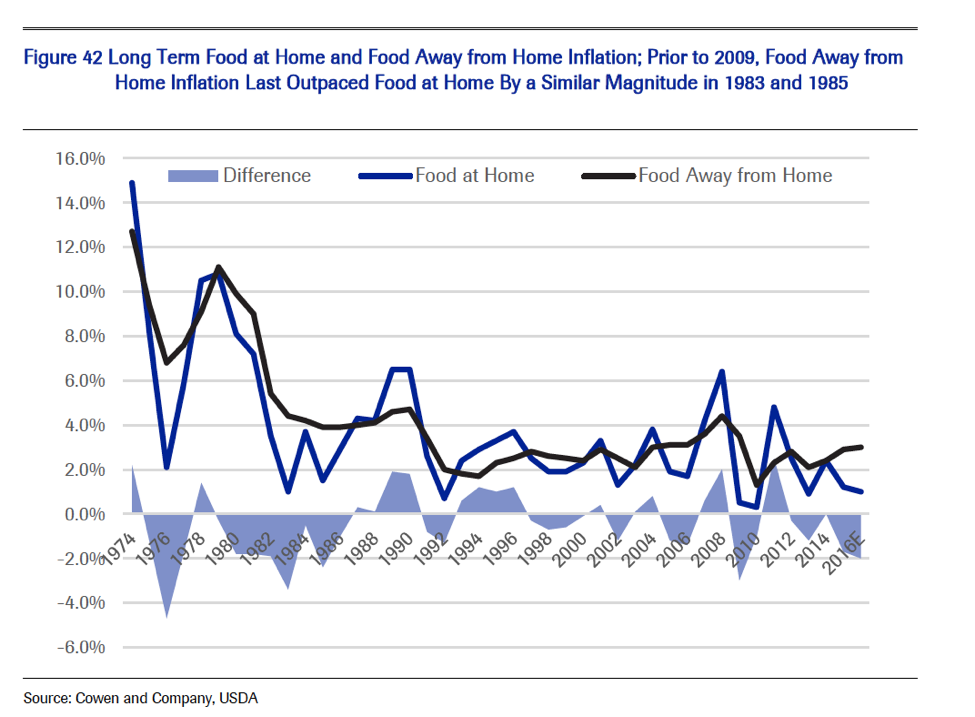April 2015 marked a milestone for the restaurant industry: For the first time ever, sales at restaurants and bars surpassed those at grocery stores.
But while the trend has continued, the restaurant industry has been struggling, with at least one investment bank analyst warning of a “restaurant recession” — an industry-wide downturn that could portend danger for the economy overall. Second-quarter earnings released in recent weeks showed disappointing same-store sales for many of the industry’s publicly traded chains, including Burger King, Chipotle, McDonald’s, Shake Shack, Wendy’s and Zoe’s Kitchen. Alongside weak same-store sales numbers, Ruby Tuesday announced earlier this month that it would close 95 restaurants.
Nation’s Restaurant News, a trade publication, reported recently that the slowdown in same-store sales is affecting almost the entire industry, with a 1.7 percent median drop in sales from the first to second quarters among companies that had reported earnings by mid-month.
Industry executives and analysts say that the turn in restaurant sales isn’t necessarily a sign of a broader consumer pullback, though. It might just reflect a shift away from those large chain eateries. And analysts point out that restaurant prices have been rising more rapidly than those at supermarkets. Falling food prices at grocery stores may simply be prompting consumers to cook more and spend less money eating out.
Related: The 25 Worst Fast Food Restaurants in 2016
“We have a value offering that continues to compete and draw customers into the restaurants, but when you look at what you pay, what you get on some of the core items, it's gotten a lot cheaper relatively speaking to go get fresh beef at your local butcher and go home and grill it,” said Todd Penegor, CEO of Wendy’s, in a call with analysts earlier this month.
Between July 2015 and July 2016, prices for “food at home” fell 1.6 percent, while prices for “food away from home” — from full-service restaurants, fast food, delivery and take-out joints, concession stands, buffets, cafeterias and even vending machines and mobile vendors — rose by 2.8 percent, according to the Bureau of Labor Statistics. The steepest drops in grocery store food prices were for meats, poultry, fish and eggs, while fruit and vegetable prices edged up 1.4 percent. The gap between supermarket inflation and restaurant inflation is at its highest point since 2009, according to analysts at investment bank Cowen and Company.

That helps explain why, since the beginning of the year, the gap in sales growth between restaurants and grocery stores has widened, according to MillerPulse, a nationwide restaurant industry data and benchmarking firm. “As grocery prices have gone down and restaurant prices have held firm, you’ve seen a decrease in traffic in restaurants,” says Larry Miller, founder of MillerPulse.

Source: MillerPulse
Related: The Restaurant Industry Is Sending a Scary Signal About the Economy
Restaurants, says Miller, aren’t easily able to hold prices down because they face rising labor costs driven by minimum wage hikes in many parts of the country. The sector employees more minimum wage workers than any other.
In addition, some industry watchers argue that grocery stores could be cutting into restaurants’ market share by increasing the quality and range of prepared foods. “Five years ago, it was meatloaf with mashed potatoes and peas on a black plastic plate that you came home and microwaved,” says longtime food industry analyst Phil Lempert, founder of supermarketguru.com. “Now it’s gone way past that to a point where supermarkets are on a daily basis offering specials the same way that you would see in a restaurant.”
Lempert says restaurants are now competing with “grocerants,” or grocery stores that offer prepared meals, often with seating areas inside the stores. Some of America’s leading grocerants include Mariano’s in the Chicago area, Shoprite and Wegmans, he says.
Related: The 20 Worst Casual Dining Restaurant Chains
Still, the outlook for the consumer isn’t completely clear. Hudson Riehle, senior vice-president of research for the National Restaurant Association, stresses that consumers are being cautious about spending.
Penegor, the Wendy’s CEO, also suggested that economic uncertainty, including uncertainty around the presidential election, has weighed on consumer spending at restaurants. “When a consumer is a little uncertain around their future and really trying to figure out what this election cycle really means to them, they're not as apt to spend as freely as they might have even just a couple of quarters ago,” Penegor said on the company’s second-quarter earnings call.
Regardless of the challenges restaurant operators face, Lempert suggests they must learn from the success of grocerants and pay closer attention to customer preferences to stay competitive.
“What restaurants need to do,” he says, “is really understand what pricing needs to be, what people are looking for in terms of a dining experience and be able to offer something unique.”




